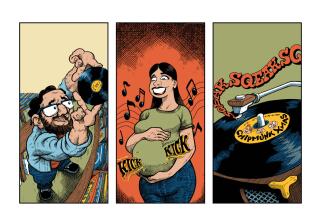CDs Going Deep Into the Catalogs
- Share via
A dozen years ago, the compact disc was a new concept, treated with considerable suspicion (“but it’s so small!”) by the classical-music crowd--conservative when it comes to new technology applied to the arts. At the time, it seemed certain that the new format would be employed only in conjunction with the newest recording technique, digital sound. And even then exclusively in standard repertory. The classical recording establishment was saying that the CD was a toy, and a toy for the hoi polloi, at that.
Once the standard repertory had been represented on CD, which didn’t take long, a surprising change occurred. In 1984, London released the first historical CD, a recording not dependent on the putative sonic wonders of digital technology or even of stereo: its 1954 Vienna recording of Mahler’s “Das Lied von der Erde,” conducted by Bruno Walter. Anything became possible after that. But while relative esoterica was at first marketed at top dollar, it has more recently become at least as common at the mid-priced and budget levels. The old credo, if buyers want something passionately enough, they’ll pay, has lost its appeal to the industry.
Today, consumers can even get little-known orchestral music, chamber music and opera, as long as it doesn’t involve the biggest name performers, at super-budget prices--for example, on labels such as Naxos that sell their CDs in the $6 to $7 range.
Take a seldom-recorded cult piece, the First Symphony of Russian composer Vassily Kalinnikov (1866-1901). The symphony is suddenly available for a pittance in an affectionate, well-executed performance by the National Symphony of the Ukraine conducted by Theodore Kuchar (Naxos 553417).
This irresistibly tuneful piece of folksy, post-Tchaikovskian schmaltz--but with a rhythmic spine--differs from the work of some minor composers who are admired mostly for sounding occasionally like the masters. Kalinnikov’s influences include Borodin, Tchaikovsky and, more distantly, Wagner, but in his First Symphony (1895), he shows sufficient personality as an orchestrator and melodist to refute accusations of aping those masters.
The composer, who died of tuberculosis at the Mozartian age of 35, seems to have expended all his creative juice on this work, as evidenced by its present disc-mate, the amiable but labored Second Symphony, written a year later.
There has to the best of my knowledge never been a cult following for Mozart’s early operas, and with the release of a new recording from Naxos (660040, two CDs), the number of complete recordings, in any format, of the 15-year-old wonder’s “Ascanio in Alba” have only now reached a total of two.
The release is conducted with stylish panache by Jacques Grimbert, director of music at the Sorbonne, its substantial choral numbers lustily sung by the university’s chorus, and the orchestra is Concerto Armonico, a fine period band from Budapest.
The vocal ensemble is dominated by the excellent countertenor Michael Chance (Orfeo in the Mark Morris-Christopher Hogwood “Orfeo ed Euridice” coming to the Wiltern Theatre in April) as the titular godling, a son of Venus, enamored of Silvia (soprano Jill Feldman), a cousin, or something, of Hercules.
Skip the plot and revel in a bubbly overture--”Figaro” in the making--followed by a succession of lively, ornate arias, jubilant choruses and some of Mozart’s most beguiling ballet music.
Two additional, equally inexpensive releases, this time reissues of early 1980s recordings of more familiar repertory, are likewise highly recommended: a set of the complete Chopin Nocturnes, played by the ever-stimulating veteran pianist Abbey Simon (Vox Box 5146, two CDs); and the Fourth and Ninth Symphonies of Bruckner, with Eugen Jochum, a master of the repertory, conducting the Dresden State Orchestra (Seraphim 68527, two CDs).
More to Read
The biggest entertainment stories
Get our big stories about Hollywood, film, television, music, arts, culture and more right in your inbox as soon as they publish.
You may occasionally receive promotional content from the Los Angeles Times.










